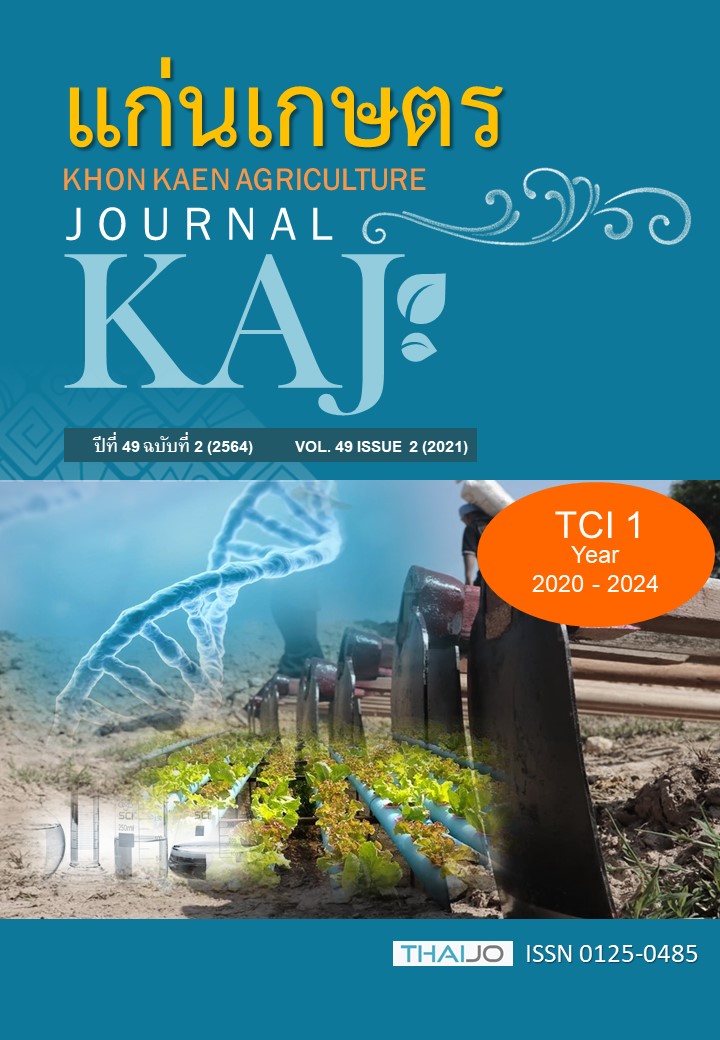ผลของปุ๋ยมูลไก่และถ่านชีวภาพต่อการเจริญเติบโต ปริมาณรงควัตถุและปริมาณธาตุอาหารใน ผักสลัดกรีนโอ๊คที่ปลูกในสภาพดินกรด
Main Article Content
บทคัดย่อ
งานวิจัยนี้มีวัตถุประสงค์เพื่อ ศึกษาประสิทธิภาพของการใช้ปุ๋ยมูลไก่และถ่านชีวภาพจากเปลือกทุเรียนต่อการเจริญเติบโต ปริมาณผลผลิต และลักษณะทางสรีรวิทยาของผักสลัดกรีนโอ๊ค โดยวางแผนการทดลองแบบ 4 x 3 factorial in completely randomized design (CRD) จำนวน 6 ซ้ำ ประกอบด้วย 2 ปัจจัย ได้แก่ ปุ๋ยมูลไก่ 4 ระดับ คือ 0, 500, 1,000 และ 2,000 กิโลกรัมต่อไร่ และถ่านชีวภาพจากเปลือกทุเรียน 3 ระดับ คือ 0, 500 และ 1,000 กิโลกรัมต่อไร่ จากผลการทดลองพบว่า การใส่ปุ๋ยมูลไก่และถ่านชีวภาพจากเปลือกทุเรียนที่เพิ่มขึ้นทำให้ความสูงที่เพิ่มขึ้น น้ำหนักสดส่วนเหนือดิน รวมถึงปริมาณคลอโรฟิลล์เอ คลอโรฟิลล์บี และคลอโรฟิลล์รวมของผักสลัดกรีนโอ๊คมีค่าเพิ่มขึ้นอย่างมีนัยสำคัญ (p≤0.05) ในขณะที่ปริมาณแคโรทีนอยด์ และปริมาณธาตุอาหารหลักในส่วนเหนือดินของผักสลัดกรีนโอ๊คมีค่าแปรผันตามระดับปุ๋ยมูลไก่ที่พืชได้รับ ทั้งนี้การใส่ปุ๋ยมูลไก่อัตรา 2,000 กิโลกรัมต่อไร่ ร่วมกับถ่านชีวภาพจากเปลือกทุเรียนอัตรา 1,000 กิโลกรัมต่อไร่ นอกจากจะทำให้ผักสลัดกรีนโอ๊คมีการเจริญเติบโตและปริมาณผลผลิตมากที่สุดแล้ว ยังส่งผลให้ปริมาณรงควัตถุ (คลอโรฟิลล์เอ คลอโรฟิลล์บี และคลอโรฟิลล์รวม) และธาตุอาหารหลักในส่วนเหนือดินมีแนวโน้มสูงที่สุด ซึ่งจากผลการวิจัยชี้ให้เห็นว่า สำหรับการปลูกผักสลัดกรีนโอ๊คในสภาพดินกรดควรมีการใส่ปุ๋ยมูลไก่ (2,000 กิโลกรัมต่อไร่) ร่วมกับถ่านชีวภาพจากเปลือกทุเรียน (1,000 กิโลกรัมต่อไร่) ซึ่งทำให้ปริมาณรงควัตถุในใบและการดูดใช้ธาตุอาหารมีค่ามากขึ้นและส่งผลให้ผักสลัดกรีนโอ๊คมีการเจริญเติบโตที่ดีกว่าการใช้ปุ๋ยมูลไก่หรือถ่านชีวภาพจากเปลือกทุเรียนเพียงอย่างเดียว
Article Details

อนุญาตภายใต้เงื่อนไข Creative Commons Attribution-NonCommercial-NoDerivatives 4.0 International License.
เอกสารอ้างอิง
กรมวิชาการเกษตร. 2548. เรื่องควรรู้เกี่ยวกับปุ๋ยอินทรีย์. แหล่งข้อมูล: http://aglib.doa.go.th/
lib/images/Downloads/2551/EB00008.pdf. ค้นเมื่อ 10 เมษายน 2563.
เกศศิรินทร์ แสงมณี. 2560. การศึกษาชนิดและอัตราส่วนของถ่านชีวภาพต่อสมบัติของดิน การเจริญเติบโต ผลผลิตและคุณภาพของกระเจี๊ยบเขียวที่ปลูกในพื้นที่ดินเปรี้ยวจัด. รายงานการวิจัย, มหาวิทยาลัยราชภัฏพระนคร, กรุงเทพฯ.
จริงแท้ ศิริพานิช. 2553. ชีววิทยาหลังการเก็บเกี่ยวและการวายของพืช. พิมพ์ครั้งที่ 3, ภาควิชาพืชสวน, คณะเกษตร, มหาวิทยาลัยเกษตรศาสตร์ วิทยาเขตกำแพงแสน, นครปฐม.
ธนพันธ์ พงษ์ไทย. 2560. ผลของโดโลไมต์ละคีเซอไรต์ต่อการเจริญเติบโตของต้นยางเล็ก. วิทยานิพนธ์ปริญญาวิทยาศาสตรมหาบัณฑิต มหาวิทยาลัยสงขลานครินทร์, สงขลา.
สัญญา เล่ห์สิงห์. 2558. อิทธิพลของปุ๋ยอินทรีย์ต่อการเจริญเติบโตและคุณภาพผลผลิตของจิงจูฉ่าย. วิทยานิพนธ์ปริญญาวิทยาศาสตรมหาบัณฑิต มหาวิทยาลัยธรรมศาสตร์, ปทุมธานี.
สุทธวรรณ วชิรธนุศร อรประภา เทพศิลปวิสุทธิ์ พักตร์เพ็ญ ภูมิพันธ์ และสมชาย ชคตระการ. 2563. ผลของปุ๋ยมูลไก่และถ่านชีวภาพต่อสมบัติทางเคมีของดินและการเจริญเติบโตของผักกาดหอมพันธุ์กรีนโอ๊คที่ปลูกในสภาพดินกรด. วารสารวิทยาศาสตร์และเทคโนโลยี. 28(2): 343-355.
ยงยุทธ โอสถสภา, อรรถศิษฐ์ วงศ์มณีโรจน์ และชวลิต ฮงประยูร. 2554. ปุ๋ยเพื่อการเกษตรยั่งยืน. พิมพ์ครั้งที่ 2, สำนักพิมพ์มหาวิทยาลัยเกษตรศาสตร์, กรุงเทพฯ.
ศิริลักษณ์ ศิริสิงห์ และอรสา สุกสว่าง. 2556. การประยุกต์ถ่านชีวภาพในการปรับปรุงดินเพื่อการเกษตร. วารสารสังคมศาสตร์และมนุษย์ศาสตร์. 39(2): 212-225.
อรประภา อนุกูลประเสริฐ และภาณุมาศ ฤทธิไชย. 2558. ผลของการใช้ปุ๋ยอินทรีย์คุณภาพสูงต่อการให้ผลผลิตและคุณภาพของผักกาดหอม. Thai Journal of Science and Technology. 4(1): 81-94.
Chintala, R., L.M. McDonald, and W.B. Bryan. 2012. Effect of soil water and nutrients on productivity of Kentucky bluegrass system in acidic soils. Journal of Plant Nutrition. 35: 288-303.
Gunes, A., A. Inal, M.B. Taskin, O. Sahin, E.C. Kaya, and A. Atakol. 2014. Effect of phosphorus-enriched biochar and poultry manure on growth and mineral composition of lettuce (Lactuca sativa L. cv.) grown in alkaline soil. Soil Use and Management. 30: 182-188.
George Mateljan Foundation. 2016.The world’s healthiest foods. http://www.whfoods.com/index.html. Accessed 10 August 2016.
Inal, A., A. Gunes, O. Sahin, M.B. Taskin, and E.C. Kaya. 2015. Impacts of biochar and processed poultry manure, applied to a calcareous soil, on the growth of bean and maize. Soil Use and Management. 31(1): 106-113.
Kansal, B.D., B. Sonsh, K.L. Bajaj, and G. Kaur. 2005. Effect of different levels of nitrogen and farmyard manure on yield and quality of spinash (Spinace oleracea L.). Plant Foods for Human Nutrition. 31: 163-170.
Khalil, Z.I., M.M.S. Asker, S. El-Sayed, and I.A. Kobbia. 2010. Effect of pH on growth and biochemical responses of Dunaliella bardawil and Chlorella ellipsoidea. World Journal of Microbiology and Biotechnology. 26: 1225–1231.
Lin, K.H., M.Y. Huang, W.D. Huang, M.H. Hsu, Z.W. Yang, and C.M. Yang. 2013. The effects of red, blue, and white light-emitting diodes on the growth, development, and edible quality of hydroponically grown lettuce (Lactuca sativa L. var. capitata). Scientia Horticulturae. 150: 86-91.
Llorach, R., A. Martinez-Sanchez, F.A. Tomas-Barberan, M.I. Gil, and F. Ferreres. 2008. Characterisation of polyphenols and antioxidant properties of five lettuce varieties and escarole. Food Chemistry. 108(3): 1028-1038.
Mackinney, G. 1941. Absorption of light by chlorophyll solutions. Journal of Biological Chemistry. 140: 315-322.
Madisa, M.E., T. Mathowa, C. Mpofu, N. Stephen, and S. Machacha. 2013. Effect of chicken manure and commercial fertilizer on performance of jute mallow (Corchorus olitorius). Agriculture and Biology Journal of North America. 4(6): 617-622.
Masarirambi, M.T., P. Dlamini, P.K. Wahome, and T.O. Oseni. 2012. Effects of chicken manure on growth, yield and quality of lettuce (Lactuca sativa L.). Journal of Agriculture and Environmental Sciences. 12(3): 399-406.
Rahman, M., and F. Akter. 2012. Effect of NPK fertilizers on growth, yield and yield attributes of okra (Abelmoschus esculentus (L.) Moench.). Bangladesh Journal of Botany. 41(2): 131-134.
Rakocevic, B.L., R. Pavlovic, J. Zdravkovic, M. Zdravkovic, N. Pavlovic, and M. Djuric. 2012. Effect of nitrogen fertilization on carrot quality. African Journal of Agricultural Research. 7(18): 2884-2900.
Robles-Aguilar, A.A., J. Pang, and J.A. Postma, S.D. Schrey, H. Lambers and N.D. Jablonowski. 2019. The effect of pH on morphological and physiological root traits of Lupinus angustifolius treated with struvite as a recycled phosphorus source. Plant Soil. 434: 65-78.
Rondon, M.A., J. Lehmann, J. Ramírez, and M. Hurtado. 2007. Biological nitrogen fixation by common beans (Phaseolus vulgaris L.) increases with bio-char additions. Biology and Fertility of Soils. 43: 699-708.
Shackley, S., S. Sohi, R. Ibarrola, J. Hammond, O. Mašek, P. Brownsort, and S. Haszeldine. 2012. Biochar as a tool for climate change mitigation and soil management. P. 183-205. In: Meyers, R. (ed.). Encyclopedia of Sustainability Science and Technology. Springer, New York, USA.
Sumeet, G., U. Shahid, and S. Suryapani. 2009. Nitrate accumulation, growth and leaf quality of spinach beet (Beta vulgaris L.) as affected by NPK fertilization with special reference to potassium. Indian Journal of Science and Technology. 2(2): 35-40.
Walkley, A., and I.A. Black. 1934. An examination of Degtjareff method for determining soil organic matter and a proposed modification of the chromic acid titration method. Soil Science. 37: 29-37.
Wang, L., C.R. Butterfly, Y. Wang, H. Herath, Y.G. Xi, and X.J. Xiao. 2014. Effect of crop residue biochar on soil acidity amelioration in strongly acidic tea garden soils. Soil Use and Management. 30: 119-128.
Whalen, J.K., C. Chang, G.W. Clayton, and J.P. Carefoot. 2000. Cattle manure amendments can increase the pH of acid soils. Soil Science Society of America Journal. 64: 962-966.
Zhang, E., Y. Duan, F. Tan, and S. Zhang. 2016. Effects of long-term nitrogen and organic fertilization on antioxidants content of tomato fruits. Journal of Horticulture. 3: 1-5.


